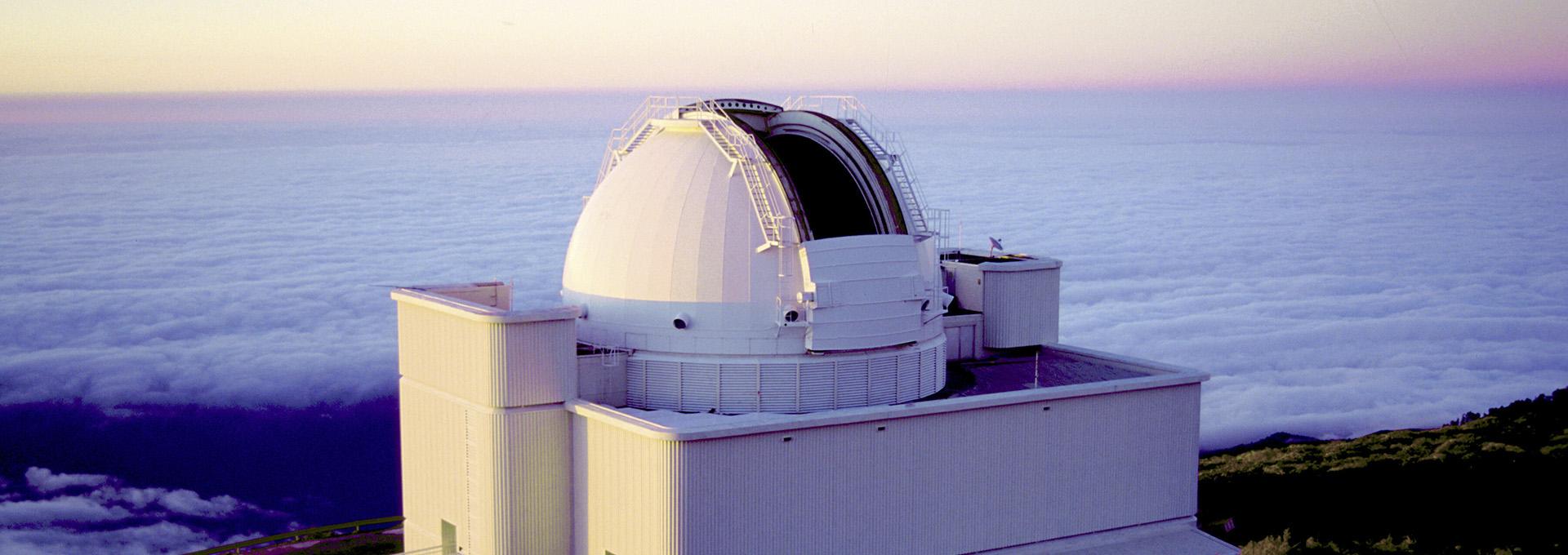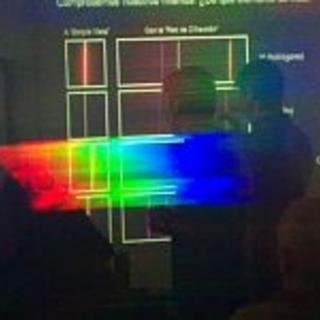Isaac Newton Telescope


The Isaac Newton Telescope (INT) has a 2.54-metre primary mirror with a focal ratio of f/2.94. It uses a polar-disc/fork type of equatorial mount. Instruments can be mounted at the corrected f/3.29 Prime or f/15 Cassegrain foci. Total weight of the telescope is about 90 tonnes.
The optical system of the INT is in a conventional Cassegrain configuration with a paraboloid primary mirror and a hyperboloid secondary. The primary has a diameter of 2.54 metres and a focal length of 7.5 metres. The primary mirror weighs 4.4 tonnes and it is made of low expansion glass-ceramic Zerodur. The telescope has a polar disc/fork type equatorial mounting.
There are two focal stations, the f/3.29 prime focus (with focal corrector) and the f/15 Cassegrain focus. Both prime and Cassegrain foci are equipped with instrument rotators and autoguiders. The autoguiders continuously analyse the image of a guide star and provide small corrections to the telescope tracking.
Since the 40s, there had been talk of providing UK astronomers with a telescope large enough to allow them to compete on equal terms with their counterparts abroad, especially in the USA and Russia. It was eventually agreed that a 100-inch telescope would be constructed, funded jointly by the Treasury and the Admiralty. The telescope would be for the use of all UK astronomers and located at Herstmonceux (Sussex, UK), where the Royal Greenwich Observatory had been moved in the 1950s. In 1967, Her Majesty the Queen performed the opening ceremony for the new Isaac Newton Telescope at Herstmonceux.
But after a number of years it became clear that better astronomical weather conditions than the UK would benefit the astronomical use of the INT. A large telescope is used to look at the faintest, most distant objects and to glean as much information as possible about them. Hence it requires the very best observing conditions that can be obtained. Such conditions are found on La Palma, and therefore it was decided in the early 1970's to move the telescope to its current location on the Roque de Los Muchachos Observatory where it resumed operation in 1984. The re-installation of the telescope was also used to modernise its instrumentation and provide the telescope out with a new, high-quality primary mirror.
The INT was officially re-inaugurated on 29 June 1985, when the inauguration of the Canary Islands observatories took place in the presence of the monarchs and members of the Royal Families of five European countries, and the Presidents of another two.
Since its first operation on La Palma, the role of the telescope has been as a facility for wide-field imaging and intermediate to low dispersion spectroscopy, and the scientific impact of the telescope is as high as that of the best telescopes of its kind.
The quantity and quality of the research carried out at the INT make it one of the best telescopes of its size in the world.
Unequivocal evidence for a stellar-size black hole in the Galaxy had been sought for decades. The X-ray transient source GS2023+338 was discovered in outburst in 1989 and was identified with the previously known recurrent nova V404 Cygni. The only certain way of identifying the primary star of the binary system as a black hole is to study the radial velocity of the less massive secondary star and measure the mass function. In order to get a good coverage of the radial velocity curve of V404 Cyg, several spectra were obtained using the William Herschel Telescope and the INT in 1992. From the mass function of the system, it was possible to set lower limits to the mass of the primary star. The astronomers obtained a measurement of 6.26 solar masses, which substantially exceeds the 3 solar masses maximum allowed mass of a neutron star. So they concluded that the compact object had to be a black hole, the first-ever stellar-size black hole detected in our Galaxy.
The WFC, since its first commissioning in 1998, has produced many scientific highlights, including the first ever detection of a dark galaxy (a galaxy made of dark matter), the discovery of new dwarf galaxies in the Local Group, the observation of the disruption of the nucleus of comet C/1999 S4 (LINEAR), the discovery of a giant stream of stars in the halo of Andromeda galaxy and a giant ring of stars surrounding the main plane of the Milky Way.
